On June 24, 2022, the Supreme Court overturned Roe v. Wade in its ruling on Dobbs v. Jackson Women’s Health Organization, declaring that the right to abortion is not protected by the U.S. Constitution and allowing states to ban abortion. Two years later, the Dobbs decision has created a fragmented and contentious healthcare environment where workers must balance their professional and ethical duties to provide care with the legal restrictions imposed by the varying state laws. This situation has led to significant challenges in delivering consistent and safe reproductive healthcare across the country.
The Harms of Abortion Bans
To understand how providers have been affected by the Dobbs decision, we surveyed them about their experiences and learned some important things.
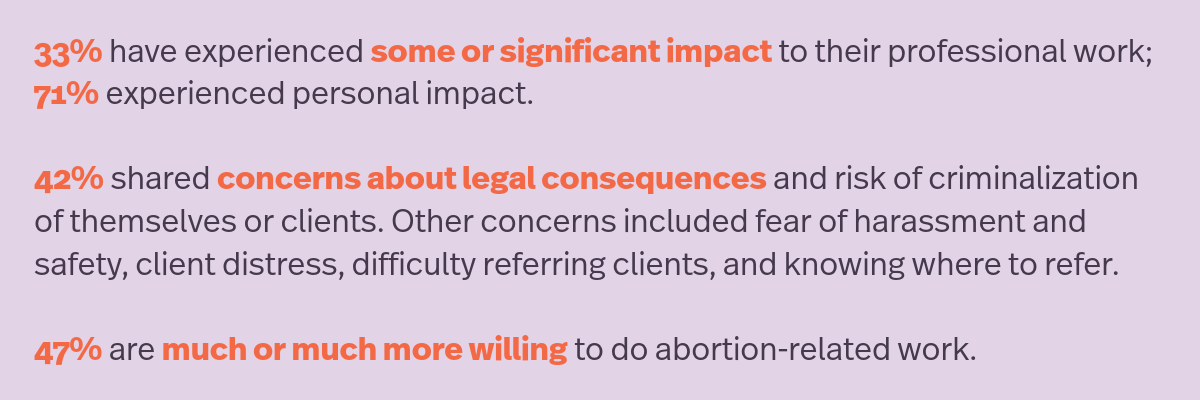
We know that banning abortion harms pregnant people, particularly in marginalized communities. But abortion bans also harm health and social service providers in ways that have legal, professional, emotional, and operational impacts:
- Legal Uncertainty and Risk
- Increased Legal Liability: Providers in states with restrictive abortion laws face significant legal risks, including potential criminal charges for performing or assisting with abortions. These risks are heightened in cases where abortion-related care is necessary for medical reasons, as providers must navigate complex legal frameworks that vary widely by state. For example, in states like Texas, physicians can face prosecution, prison time, and loss of their medical license for performing abortions that are later deemed illegal by state authorities. This fear of prosecution extends not only to doctors, but also nurses, pharmacists, and administrative staff involved in reproductive healthcare.
- Ambiguity in Laws: The variability and ambiguity in state laws create uncertainty for providers. Many state laws are vaguely worded, leaving providers unsure about what constitutes legal vs. illegal care. This lack of clarity increases the risk of unintentional legal violations, as providers struggle to interpret and comply with new regulations. This legal uncertainty can lead to delays or denial of necessary care, further endangering patient health.
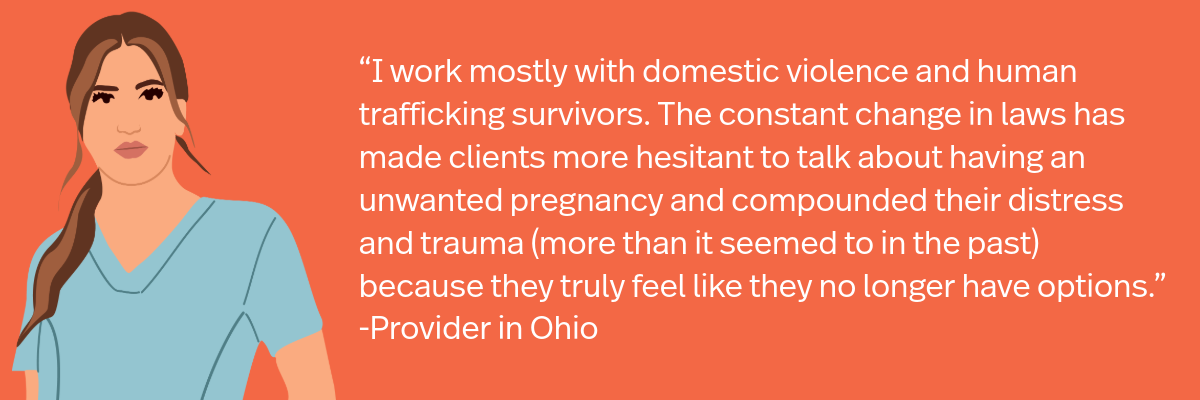
- Impact on Patient Care
- Delayed or Denied Care: Legal restrictions have forced providers to delay or deny necessary medical care—even in emergencies—resulting in negative health outcomes for patients and placing providers in ethically challenging situations. Last year, a Kaiser Family Foundation survey found that 68% of office-based OB-GYNs said that the Dobbs decision has worsened their ability to managed pregnancy-related emergencies, and 40% of OB-GYNs practicing in a state with a ban said they personally felt constrained in their ability to manage miscarriages and pregnancy-related medical emergencies.
- Referrals and Logistical Challenges: Providers in restrictive states must navigate complex referral systems to send patients to states where abortion remains legal. In addition to delaying time-sensitive care, this adds logistical burdens for patients, including travel, financial burdens, and delays in receiving care.
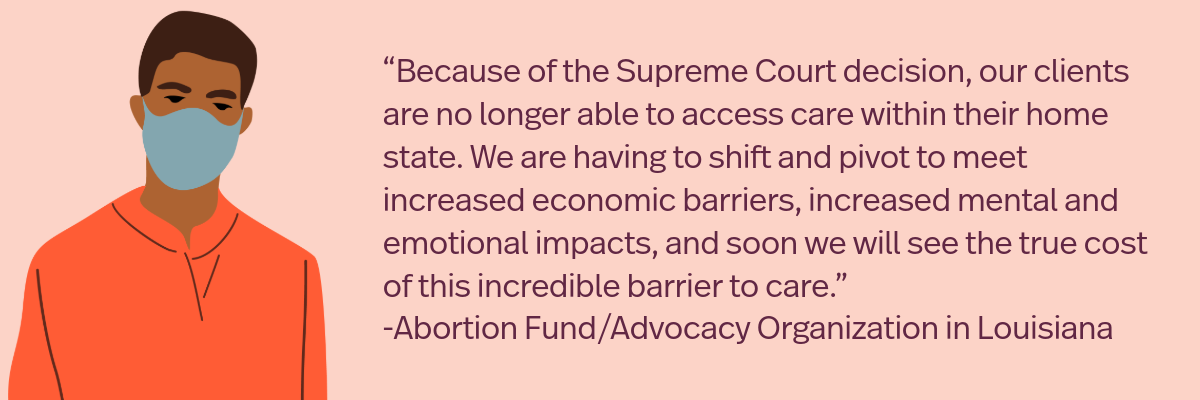
- Strain on Healthcare Systems in States Where Abortion is Legal
- Increased Patient Load: States where abortion remains legal are seeing a surge in patients from restrictive states. This influx is straining clinics and healthcare systems, leading to longer wait times and stretched resources.
- Resource Allocation: Clinics in these states are diverting more resources to accommodate out-of-state patients, which can impact the availability of services for local residents.
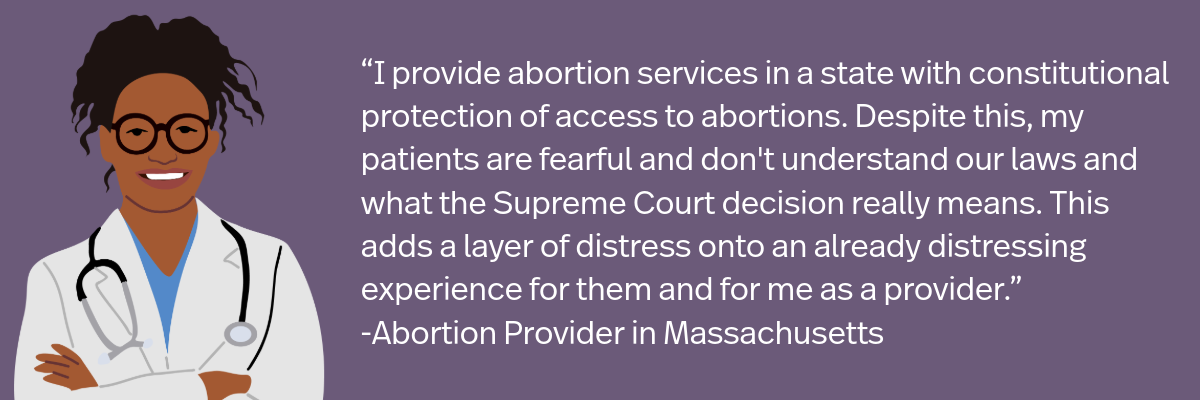
- Emotional and Ethical Strain
- Moral Distress: Providers experience moral distress when unable to offer medically necessary care due to legal restrictions. This conflict between professional duty and legal constraints can lead to significant emotional strain.
- Burnout: The increased workload, legal risks, and emotional strain are contributing to higher levels of burnout among providers. The emotional toll of navigating these complexities can lead to fatigue, anxiety, and depression. Many providers report feeling overwhelmed and demoralized by the current legal landscape.
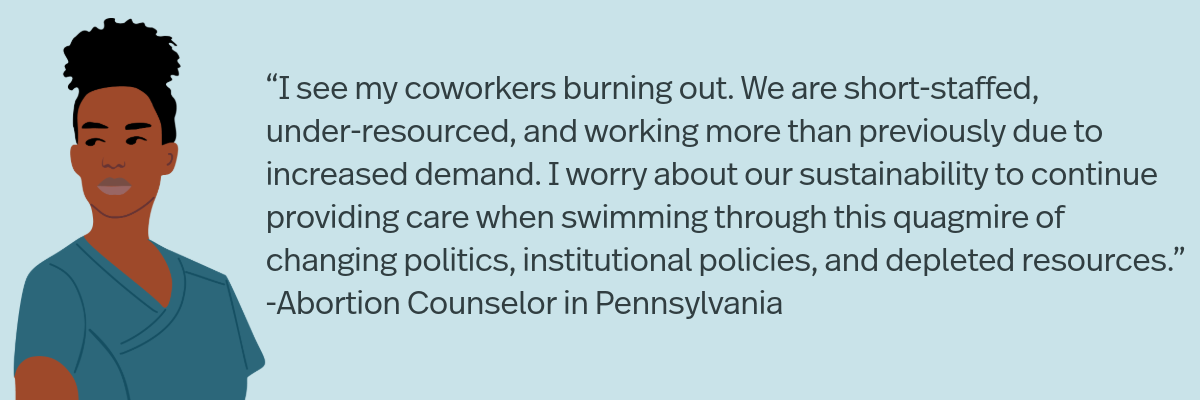
- Operational and Administrative Challenges
- Policy Adjustments: Healthcare facilities must continuously update their policies and protocols to comply with changing laws, which can be a complex and ongoing process that requires significant administrative effort and resources.
- Patient Communication: Providers must carefully navigate how they communicate with patients about their options and the legal constraints, often requiring legal counsel to ensure compliance with state laws.

- Stigmatization and Safety Concerns
- Increased Stigma: Providers who offer abortion services face increased stigmatization and harassment. This societal pressure can affect their personal and professional lives, leading to isolation and decreased job satisfaction.
- Safety Risks: Heightened visibility and activism around abortion can lead to increased safety risks for providers, including threats and acts of violence. Security concerns necessitate additional measures to protect staff and patients.
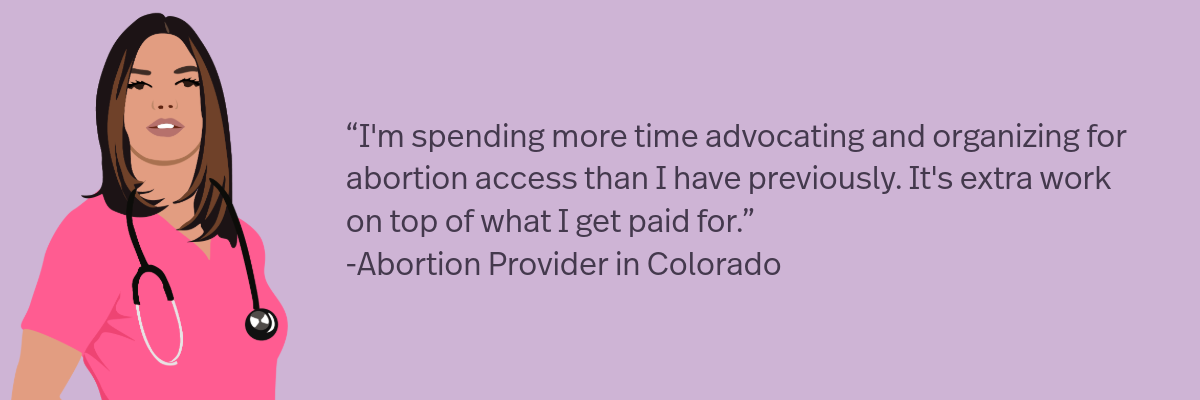
- Impact on Training and Education
- Reduced Training Opportunities: Restrictions on abortion services limit opportunities for medical students and residents to receive comprehensive training in reproductive healthcare. Recent data shows that medical residents are starting to avoid states with abortion bans. This impacts the future workforce’s ability to provide necessary care and exacerbates the shortage of physicians in rural and underserved areas.
- Curriculum Changes: Medical schools and training programs may need to alter their curricula to comply with state laws, potentially reducing the quality and scope of education in reproductive health.

Solutions to Harmful Abortion Bans
The impacts of the Dobbs decision undermine providers’ ability to deliver comprehensive and ethical reproductive care. Leadership operating in critical systems of care that serve people of reproductive age can play a crucial role in supporting health and social service providers harmed by abortion bans. Not only should we aim to protect and support providers, but we should also strive to restore and advance reproductive rights and access to care.
Provide offers free professional development for healthcare and social service providers to give accurate, informed, and nonjudgmental referrals for abortion care. Through training and technical assistance, we partner with organizations and leadership to integrate abortion referral practices into their standards of care. Here are some specific actions leadership can take to combat the harms of abortion bans:
- Education and Training
- Regular Training: Offer regular training sessions on current laws, legal risks, and best practices for handling cases impacted by abortion bans. Ensure staff are informed and confident in their knowledge.
- Ethics and Coping Strategies: Include training on ethics and coping strategies to help workers manage the moral and emotional stress associated with restrictive laws.
- Check out our training on Centering Ethics and Autonomy in Pregnancy Options Counseling.
- If your site is interested in burnout prevention training or other training support, reach out for an assessment.
- Professional Development
- Continuing Education: Support continuing education opportunities for staff. This can help staff stay updated on best practices and new developments in the abortion access landscape.
- Career Development: Encourage career development through mentorship programs, leadership training, and opportunities for advancement within the organization.
- Supportive Work Environment
- Open Communication: Foster a culture of open communication where workers feel safe discussing their concerns and suggestions. Regular check-ins and feedback sessions can help address issues early.
- Recognition and Appreciation: Regularly recognize and appreciate the hard work and dedication of staff. This is crucial for boosting morale and job satisfaction, mitigating burnout, and fostering a positive work culture.
- Operational Adjustments and Support
- Flexible Work Schedules: Offer flexible work schedules to help workers manage stress and avoid burnout. Ensure they have adequate time off and access to rest periods.
- Resource Allocation: Allocate resources to ensure that staff are not overburdened. This might include hiring additional staff, redistributing tasks, and ensuring that facilities have the necessary equipment and support.
- Safety and Security
- Enhanced Security Measures: Implement enhanced security measures to protect workers from harassment and threats. This can include physical security at facilities, online safety protocols, and legal protections.
- Support Systems: Develop robust support systems for workers facing harassment or threats, including legal support, counseling, and crisis intervention.
- Collaborative Efforts
- Form Alliances: Form alliances with other healthcare organizations, advocacy groups, and professional associations. A united front provides stronger support and more effective advocacy.
- Resource Sharing: Share resources, including legal, educational, and emotional support resources, with other organizations facing similar challenges.
- Documentation and Research
- Document Impact: Systematically document the impact of abortion bans on health and social service providers. This data can be used to inform policy, advocacy, and legal challenges.
- Conduct Research: Support or conduct research on the broader impacts of restrictive abortion laws. Use findings to advocate for change and to educate the public and policymakers.
- Policy Advocacy and Legal Support
- Advocate for Policy Changes: Engage in advocacy efforts to push for policy changes that protect reproductive rights and the autonomy of providers. Work with lawmakers, professional organizations, and advocacy groups to influence legislation.
- Legal Resources: Provide access to legal counsel for workers. Ensure that they have the resources to understand and navigate the legal landscape, including protection from potential litigation.
- Advocacy and Community Engagement
- Public Advocacy: Engage in public advocacy to raise awareness about the challenges and harms caused by abortion bans. Use organizational platforms to amplify the voices of providers and advocates.
- Community Outreach: Participate in community outreach to build public support for reproductive rights. Organize or support events, forums, and educational campaigns to engage the community.
Abortion bans have placed significant burdens on providers, necessitating a proactive and multifaceted response from leadership within critical care systems. By advocating for policy changes, providing robust legal and emotional support, and fostering a positive and appreciative work environment, leaders can help mitigate the harms caused by restrictive abortion laws. Together, through bold advocacy, support, and community engagement, we can work towards a more equitable health system that cares for every person with dignity and respect.
Has the Dobbs decision impacted your ability to provide quality, stigma-free care for the people you serve? Please tell us your story.
